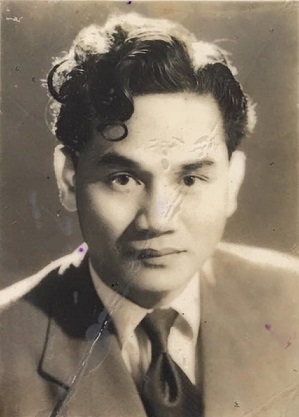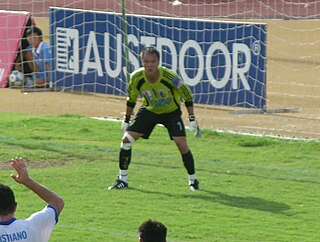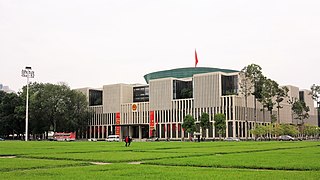Related Research Articles

Ngô Xuân Diệu was a Vietnamese poet, journalist, short-story writer, and literary critic, best known as one of the prominent figures of the twentieth-century Thơ mới Movement. Heralded by critics as "the newest of the New Poets", Xuân Diệu rose to popularity with the collection Thơ thơ (1938), which demonstrates a distinct voice influenced by Western literature, notably French symbolism. Between 1936 and 1944, his poetry was characterized by a desperation for love, juxtaposed with a desire to live and to experience the beauty of the world. After joining the Vietnamese Communist Party in 1945, the themes of his works shifted towards the Party and their resistance against the French and the Americans. When he died in 1985, he left behind about 450 poems, as well as several short stories, essays, and literary criticisms.

The Bahnar or Ba-Na (Vietnamese pronunciation:[ɓaː˧naː˧] are an ethnic group of Vietnam and the indigenous people of the Central Highland provinces of Gia Lai and Kon Tum, as well as the coastal provinces of Bình Định and Phú Yên. They speak the Bahnar language, a language in the Bahnaric language group that belongs to the Mon-Khmer language family.

Vietnamese art is visual art that, whether ancient or modern, originated in or is practiced in Vietnam or by Vietnamese artists.

Paris By Night 89: In Korea is a Paris By Night program that was filmed at the Olympic Fencing Gymnasium at the Olympic Park in Seoul, South Korea on Sunday, July 1, 2007. It is Thúy Nga's first venture into Asia to tape a Paris By Night program. Thúy Nga chose to tape at South Korea, rather than any other country in Asia simply because of the popularity of Korean actors and singers to the Vietnamese community. The program is directed by a Korean director, Seounghyun Oh. It is Thúy Nga's fourth "Live" show.

Dương Hồng Sơn is a Vietnamese football manager and former player who is the manager of Quang Nam. He is best known for his performance helping the Vietnam national team to win their first ASEAN Championship. He was declared 2008 AFF Suzuki Cup MVP of the tournament.
Trần Thu Hà, also known as Hà Trần is a Vietnamese singer and producer. She is considered by the public and critics as one of the four divas in Vietnam, alongside Thanh Lam, Hồng Nhung, and Mỹ Linh.
Thierry Bernard-Gotteland is a French artist. He lives and works among France and Vietnam.
Ho Chi Minh Thought is a political philosophy that builds upon Marxism–Leninism and the ideology of Vietnamese revolutionary Ho Chi Minh. It was developed and codified by the Communist Party of Vietnam and formalised in 1991. The term is used to cover political theories and policies considered as representing a form of Marxism–Leninism that has been adapted to Vietnamese circumstances and history. The ideology includes views on the basic issues of the Vietnamese Revolution, specifically the development and application of Marxism–Leninism to the material conditions of Vietnam.
Nha San Collective is the first and longest-running, non-profit, artist-run space for experimental art that was realized in the political scene in Vietnam. It has been a pioneer in facilitating an experimental art movement and in promoting contemporary culture.
Nguyen Phuong Linh is a Vietnamese born, Hanoi-based conceptual artist. Nguyen Phuong Linh's multidisciplinary practice spans installation, sculpture and video. Her work conveys the sense of the alienation, the dislocation and the ephemerality of human life.
Nguyen Manh Hung is a Vietnamese multidisciplinary artist based in Ho Chi Minh City.
Nguyễn Trinh Thi is a Hanoi-based independent filmmaker, documentarian, and video artist. She is known for her layered, personal, and poetic approach to contentious histories and current events through experiments with the moving image. Regarded as one of the pioneers of her home country Vietnam's independent cinema, Thi is seen as the most notable video artist in Vietnam's contemporary art scene. She plays an important role in the country's cinema, with works shown in international festivals and exhibitions.
Bang Nhat Linh is a Vietnamese contemporary artist based in Hanoi. His works are usually simple but multi-layered, dreamy and humane. They reflect the surveys into the depths of the psychological spaces, memories, history, submerged and of the oblivion in which "war memorabilia are removed from their original contexts to be placed within another context, or positioned in a relationship with human as communicable and interactive objects.

Army and warfare made their first appearance in Vietnamese history during the 3rd millennium BC. Throughout thousands of years, wars played a great role in shaping the identity and culture of people inhabited the land which is modern day Vietnam.
Phạm Thanh Tâm was a Vietnamese journalist and war artist, who used the pen name Huỳnh Biếc. His career spanned the First Indochina War as a Việt Minh soldier participating in the resistance against French colonialism, as well as the Second Indochina War as a member of the People's Army of Vietnam against South Vietnam and the United States.
Thảo Nguyên Phan is a Vietnamese visual multimedia artist whose practice encompasses painting, filmmaking, and installation. She currently lives and works in Ho Chi Minh City and has exhibited widely in Vietnam and abroad. Drawing inspiration from both official and unofficial histories, Phan references her country's turbulent past while observing ambiguous issues in social convention, history, and tradition. She has exhibited in solo and group exhibitions in Vietnam and abroad, at many public institutions, including the Factory Contemporary Art Centre, Ho Chi Minh City; Nha San Collective, Hanoi; Rockbund Art Museum, Shanghai; Times Art Center in Berlin, Timișoara; and the Mistake Room, Los Angeles.

The National Assembly Building of Vietnam, officially the National Assembly House and also known as the New Ba Đình Hall, is a public building located on Ba Đình Square across from the Ho Chi Minh Mausoleum in Hanoi, Vietnam. Construction started on October 12, 2009, and finished on October 20, 2014. The building is used by the National Assembly of Vietnam for its sessions and other official functions.

The abdication of Bảo Đại took place on 25 August 1945 and marked the end of the 143-year reign of the Nguyễn dynasty over Vietnam ending the Vietnamese monarchy. Emperor Bảo Đại abdicated in response to the August Revolution. A ceremony was held handing power over to the newly established Democratic Republic of Vietnam, which was established during the end of World War II in Asia as Vietnam had been occupied by French and later Japanese imperialists.

Tuan Andrew Nguyen is a Vietnamese-American artist known for moving-image works, sculptures and installations. His work taps into counter-memory, testimony and dialogue as forms of political resistance and empowerment, highlighting unofficial and underrepresented histories involving the fragmented consciousness of colonial inheritance and the cultural estrangement of expatriation and repatriation. He interweaves factual and speculative elements—archival resources, fiction, explorations of material memory embedded in objects (animism), and supernatural realms—in order to rework dominant narratives into poetic vignettes that imagine alternate forms of healing, survival and political potentiality. In 2023, New York Times critic Roberta Smith wrote, "Nguyen is a documentarian and an assembler of broken things with a preference for collaboration. His work aims to heal the fragmented lives and retrieve the suppressed memories of the marginalized people most affected by colonization, war and displacement, especially in Vietnam."
References
- ↑ "Nguyen Huy An". GalerieQuynh.
- ↑ "NGUYEN HUY AN - Skylines With Flying People". Skylines With Flying People.
- ↑ "Artist Talk with Nguyen Huy An".
- ↑ "Interview with Nguyen Huy An - Asia Art Archive".
- ↑ "olio. v2". GalerieQuynh.
- 1 2 "14. İstanbul Bienali / 14th Istanbul Biennial".
- ↑ October CMS. "Nha San Collective - Nguyen Huy An".
- ↑ "ArtFacts.net". ArtFacts.net.
- ↑ "Nguyen Huy An".